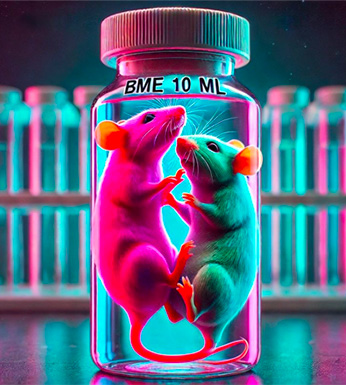
A project funded by FC3R

Rosette, a project funded by FC3R, aims to identify reliable alternative matrices of non-animal origin to generate a 3D model of pluripotency with embryonic stem cells.
The case for moving beyond BME
The basement membrane is an important extracellular matrix (ECM) that is found in all epithelial and endothelial tissues, which helps to maintain tissue growth and function. A substitute mixture of ECM proteins, « Basement Membrane Extracts » (BME), has been widely used for over 40 years in cell cultures (2D and 3D) to mimic this extracellular environment and support cellular functions in vitro (Benton et al., 2014).
The primary source of BME is the Engelbreth-Holm-Swarm (EHS) mouse tumor, a type of murine sarcoma that produces large amounts of basement membrane material. This tumor was originally identified in a mouse and has since been propagated for the purpose of extracting these ECM components. To produce BME, mice are injected with EHS cells and allowed to develop tumors, until they reach about 2-3mm3 or 10% of the mouse body weight. Tumors are then harvested from the animals, and prepared into BME - better known under the trade names Matrigel®, Cultrex® or GeltrexTM.
The animal origin of the material poses significant scientific and practical challenges concerning biological relevance, reproducibility and transferability to human, while raising major ethical concerns. To build awareness of these limitations and promote the use of animal-free alternatives, the 3Rs Centre Utrecht conducted a weekly LinkedIn campaign from 6th of May to 10th of June, 2025. The posts spotlighted six compelling arguments to make the switch to replacing BME with defined non-animal matrices:
1. BME lacks organ-specific precision
Every tissue in the body has a unique ECM composition that guides cell behavior and function. Because BME cannot be tuned to mimic the tissue-specific properties of every tissue, it fails to provide the precise microenvironment required for many applications, potentially compromising the physiological relevance of experimental models.
2. Batch-to-batch variability hinders reproducibility
One of the most significant scientific drawbacks of BME is its high batch-to-batch variability—studies have shown only about 53% similarity between batches. This inconsistency undermines the reproducibility of experiments and prevents to obtain reliable results.
3. Tumor extracts do not represent healthy tissues
BME is derived from Engelbreth-Holm-Swarm (EHS) mouse tumors, making its composition fundamentally different from the ECM of healthy human tissues. It often contains proteins associated with inflammation and tissue remodeling, which can skew results toward cancer biology rather than normal physiology. This can lead to misleading data and missed breakthroughs in understanding healthy tissue function.
4. Xenogeneic origin limits clinical translation
Because BME is of murine origin, it introduces biological incompatibilities when culturing human cells. This not only affects experimental outcomes but also poses regulatory barriers for clinical applications, as agencies like the EMA and FDA increasingly require xeno-free, defined materials for human therapies.
5. Production of BME is unethical and unsustainable
The production of BME is resource-intensive and involves significant animal suffering. Each 10 mL bottle of BME requires the sacrifice of two mice, which are bred and injected with tumors specifically for this purpose. This practice is both inhumane and at odds with the ethical and political imperative to reduce animal use in research.
6. BME-containing models are never completely animal-free
As long as BME is used, research models cannot be considered truly animal-free. This undermines efforts to develop more human-relevant, ethical, and reproducible models for drug screening, disease modeling, and personalized medicine. Transitioning to defined, animal-free matrices is essential for advancing the 3Rs (Replacement, Reduction, Refinement) while making progress in biomedical research.

Time for a change: alternatives and resources
Recognizing these challenges, the 3Rs Centre Utrecht has developed and recently launched a resource to help researchers identify and adopt defined, animal-free alternatives to BME for their specific needs: the BME-free Database.
Researchers can explore a wide range of defined, animal-free matrices that support cell growth and differentiation in both 2D and 3D models, such as synthetic hydrogels, recombinant extracellular matrix proteins, and other matrices tailored for specific tissues and applications.
This freely accessible database aims to support the shift toward more ethical, reproducible, and sustainable research methods, by offering researchers curated alternatives to animal-derived BME.
Animal-derived products have long been standard in in vitro research, supporting the growth and differentiation of cells and organoids. However, as the scientific community advances toward more ethical, reproducible, and clinically relevant models, their limitations become increasingly apparent. Replacing BME with defined, animal-free alternatives meets the ethical imperative to reduce animal use in research, and is a scientific necessity for reproducibility, clinical translation, and innovation. By leveraging new resources and technologies, researchers can build more reliable, human-relevant models that accelerate progress in biomedical science.
